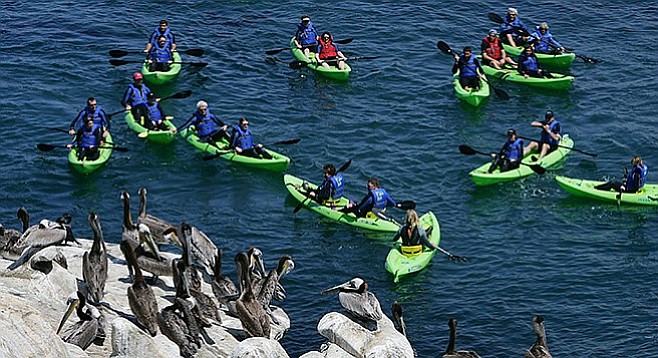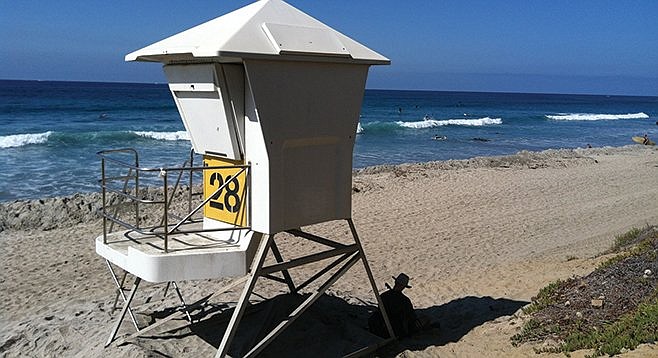 Facebook
Facebook
 X
X
 Instagram
Instagram
 TikTok
TikTok
 Youtube
Youtube

About 40 percent of the City of San Diego's Lifeguard Services’ full-time lifeguards will be eligible to retire within the next five years, which is both good and bad, according to city auditors.

The departure of highly skilled but aging water rescuers poses a risk to public safety.
On the other hand, the auditors say, the approaching turnover in the ranks provides an opportunity to shake up the traditionally white male culture of the city's tightly knit lifeguard corps.
"Lifeguard Services Division risks facing a critical skills gap in the next five to ten years," says the May 27 report from the office of city auditor Eduardo Luna.
"Our analysis of Lifeguard Services demographic data revealed that the Lifeguard Services’ workforce is potentially approaching a wave of retirements that will affect available skill sets."
Notes the document, "Currently, about 20 percent of the Lifeguard Services operations workforce has been with the City in a full-time capacity for at least 20 years. Another 18 percent has been with the City in a full-time capacity for 15 to 20 years. Therefore, in five years almost 40 percent of Lifeguard Services’ current classified workforce will have 20 or more years of service with the City."
According to the report, Lifeguard Services, a division of the Fire-Rescue Department, "employs approximately 100 full-time lifeguards, and hires additional part-time lifeguards to increase beach and bay coverage during the summer months.”
Additionally, “Lifeguard Services’ Boating Safety Unit provides ocean rescue services to boaters, and staffs the Lifeguard Services Communication Center 24-hours per day. Lifeguard Services also has river, dive, and cliff rescue personnel who are certified for underwater criminal investigations."
Because lifeguarding skills "can take years to develop and internally certify," says the audit, "a formalized workforce plan" needs to be quickly developed.
Near the top of the to-do list, the document suggests, should be race and gender.
"Historically, Lifeguard Services is a predominately Caucasian male workforce," say the auditors. "Lifeguard Services’ staff is not representative of the County labor force in terms of Hispanic, Asian, or Pacific Islander ethnicities. Females are also under-represented."
The report notes that that there are just seven females among San Diego's 102 full-time lifeguards, or 6.8 percent, compared to L.A. County with "11 female full-time lifeguards out of the 155 total full time lifeguards — about 7.1 percent of the workforce."
On the other hand, the document says, "the cities of Coronado, Del Mar, Encinitas, Imperial Beach, and Oceanside do not staff any female full-time lifeguards."
Auditor Luna makes a number of suggestions to correct the situation.
"In order to bring Lifeguard Services into conformance with the labor force availability of San Diego, it should improve its recruitment of Hispanic and female individuals.”
According to the audit, “Because of the potential increase in separations and retirements in Lifeguard Services, now is an opportunity for Lifeguards to incorporate additional specific strategies to augment workforce-diversifying recruiting efforts."
Recommends the report, "To identify potential barriers to hiring, Lifeguard Services should review its educational, fitness and background requirements to ensure that these do not pose any unnecessary barriers to diversifying its workforce."
In addition, "Since the 'face' of an organization that most people will first see is its website, diversity should be reflected on the website. This includes everything from the mission statement, to the employees shown online, to corporate videos and testimonials from employees themselves."
The city's recruitment campaign should also "employ internet advertising over relevant websites such as Latinos for Hire, Women for Hire, and AfricanAmericanJobsite.com," the audit says.
"This approach not only affects the bottom line but also ensures that workforce is representative of clients—in this case, beachgoers."
Paying for the new hires, as well as unfunded capital projects, will pose a costly new challenge, for which the audit offers a solution in the form of higher fees from beach concessions.
"Currently, the surf camp and kayak concession contracts require that 10 percent of gross sales be paid to the City where the total annual revenues are above a minimum threshold. According to revenue audits conducted by the City Treasurer’s Office, between June 2008 and September 2013—a period of 64 months—the total gross revenues generated by the surf camp and kayak concessions was more than $23.5 million and the amount of fees due to the City was more than $2.4 million."

But, as previously reported here, the mayor and city council's process of handing out beach-use contracts has become highly politicized, with the use of well-connected lobbyists by would-be concessionaires almost mandatory.
The result has been lower fees for favored contractors than charged elsewhere, insiders say.
"Increasing the percentage on gross revenue would bring the City’s concession contracts in line with other California cities," says the audit.
"Additionally, the City could generate an additional $115,077 to $314,151 annually if the City changes contract terms to require percentage on gross revenue between 12 to 15 percent for both the surf camps and kayak rental businesses."
Officials "should review the fee terms of the concession contracts to ensure that the City receives a percentage of annual concession revenue consistent with other municipalities’ contracts with concessionaires operating on public beaches.”
Additionally, “when preparing the [request for proposals], the departments should also review the level of operational support needed to ensure safe operations of concession activities."

In a May 22 response, fire chief Javier Mainar agreed with the audit's findings, vowing to develop a workforce plan "to incorporate a recruiting element tailored to increase ethnicity and gender diversity," to be completed by November 30.
In addition, Mainair said, the city will "review the Kayak Concession fee terms in 2018 prior [to] it either exercising the first one-year extension or issuing a new [request for proposal]. Staff will review fee terms for Surf Camps in 2019. If a yet-to-be-identified beach concession activity requires [a request for proposal] sooner, the review and evaluation as described above would occur."


About 40 percent of the City of San Diego's Lifeguard Services’ full-time lifeguards will be eligible to retire within the next five years, which is both good and bad, according to city auditors.

The departure of highly skilled but aging water rescuers poses a risk to public safety.
On the other hand, the auditors say, the approaching turnover in the ranks provides an opportunity to shake up the traditionally white male culture of the city's tightly knit lifeguard corps.
"Lifeguard Services Division risks facing a critical skills gap in the next five to ten years," says the May 27 report from the office of city auditor Eduardo Luna.
"Our analysis of Lifeguard Services demographic data revealed that the Lifeguard Services’ workforce is potentially approaching a wave of retirements that will affect available skill sets."
Notes the document, "Currently, about 20 percent of the Lifeguard Services operations workforce has been with the City in a full-time capacity for at least 20 years. Another 18 percent has been with the City in a full-time capacity for 15 to 20 years. Therefore, in five years almost 40 percent of Lifeguard Services’ current classified workforce will have 20 or more years of service with the City."
According to the report, Lifeguard Services, a division of the Fire-Rescue Department, "employs approximately 100 full-time lifeguards, and hires additional part-time lifeguards to increase beach and bay coverage during the summer months.”
Additionally, “Lifeguard Services’ Boating Safety Unit provides ocean rescue services to boaters, and staffs the Lifeguard Services Communication Center 24-hours per day. Lifeguard Services also has river, dive, and cliff rescue personnel who are certified for underwater criminal investigations."
Because lifeguarding skills "can take years to develop and internally certify," says the audit, "a formalized workforce plan" needs to be quickly developed.
Near the top of the to-do list, the document suggests, should be race and gender.
"Historically, Lifeguard Services is a predominately Caucasian male workforce," say the auditors. "Lifeguard Services’ staff is not representative of the County labor force in terms of Hispanic, Asian, or Pacific Islander ethnicities. Females are also under-represented."
The report notes that that there are just seven females among San Diego's 102 full-time lifeguards, or 6.8 percent, compared to L.A. County with "11 female full-time lifeguards out of the 155 total full time lifeguards — about 7.1 percent of the workforce."
On the other hand, the document says, "the cities of Coronado, Del Mar, Encinitas, Imperial Beach, and Oceanside do not staff any female full-time lifeguards."
Auditor Luna makes a number of suggestions to correct the situation.
"In order to bring Lifeguard Services into conformance with the labor force availability of San Diego, it should improve its recruitment of Hispanic and female individuals.”
According to the audit, “Because of the potential increase in separations and retirements in Lifeguard Services, now is an opportunity for Lifeguards to incorporate additional specific strategies to augment workforce-diversifying recruiting efforts."
Recommends the report, "To identify potential barriers to hiring, Lifeguard Services should review its educational, fitness and background requirements to ensure that these do not pose any unnecessary barriers to diversifying its workforce."
In addition, "Since the 'face' of an organization that most people will first see is its website, diversity should be reflected on the website. This includes everything from the mission statement, to the employees shown online, to corporate videos and testimonials from employees themselves."
The city's recruitment campaign should also "employ internet advertising over relevant websites such as Latinos for Hire, Women for Hire, and AfricanAmericanJobsite.com," the audit says.
"This approach not only affects the bottom line but also ensures that workforce is representative of clients—in this case, beachgoers."
Paying for the new hires, as well as unfunded capital projects, will pose a costly new challenge, for which the audit offers a solution in the form of higher fees from beach concessions.
"Currently, the surf camp and kayak concession contracts require that 10 percent of gross sales be paid to the City where the total annual revenues are above a minimum threshold. According to revenue audits conducted by the City Treasurer’s Office, between June 2008 and September 2013—a period of 64 months—the total gross revenues generated by the surf camp and kayak concessions was more than $23.5 million and the amount of fees due to the City was more than $2.4 million."

But, as previously reported here, the mayor and city council's process of handing out beach-use contracts has become highly politicized, with the use of well-connected lobbyists by would-be concessionaires almost mandatory.
The result has been lower fees for favored contractors than charged elsewhere, insiders say.
"Increasing the percentage on gross revenue would bring the City’s concession contracts in line with other California cities," says the audit.
"Additionally, the City could generate an additional $115,077 to $314,151 annually if the City changes contract terms to require percentage on gross revenue between 12 to 15 percent for both the surf camps and kayak rental businesses."
Officials "should review the fee terms of the concession contracts to ensure that the City receives a percentage of annual concession revenue consistent with other municipalities’ contracts with concessionaires operating on public beaches.”
Additionally, “when preparing the [request for proposals], the departments should also review the level of operational support needed to ensure safe operations of concession activities."

In a May 22 response, fire chief Javier Mainar agreed with the audit's findings, vowing to develop a workforce plan "to incorporate a recruiting element tailored to increase ethnicity and gender diversity," to be completed by November 30.
In addition, Mainair said, the city will "review the Kayak Concession fee terms in 2018 prior [to] it either exercising the first one-year extension or issuing a new [request for proposal]. Staff will review fee terms for Surf Camps in 2019. If a yet-to-be-identified beach concession activity requires [a request for proposal] sooner, the review and evaluation as described above would occur."
Comments